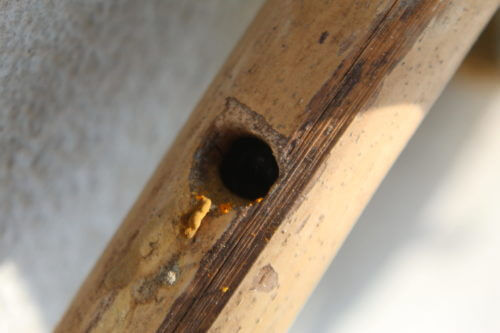Carpenter Bee Facts & Information
Everything you need to know about carpenter bees
What Do Carpenter Bees Look Like

Carpenter bees can be black, green, or purplish. The rear portion of the body (abdomen) alternates with dark and orange-yellowish bands. Because of the stripes, carpenter bees can be confused with honeybees. The good news is our Board Certified Entomologists know the difference and will provide carpenter bee treatments that will not harm the sacred and beloved honeybees!
Carpenter bees do not live in colonies like honeybees or bumblebees. The adults overwinter individually, often in previously constructed brood tunnels. Those that survive the winter emerge and mate the following spring. Fertilized female carpenter bees then bore into wood, excavating a tunnel to lay their eggs. The entrance hole in the wood surface is perfectly round and about the diameter of your little finger. Coarse sawdust may be present below the opening, and tunneling sounds are sometimes heard within the wood. After boring in a short distance, the bee makes a right angle turn and continues to tunnel parallel to the wood surface. Inside the tunnel, about five or six cells are constructed for housing individual eggs. Working back to front, the bee provisions each cell with pollen (collected from spring-flowering plants) and a single egg, sealing each successive chamber with regurgitated wood pulp. Hatching and maturation occurs over several weeks, with the pollen serving as a food source for the developing larvae. Later in the summer, the new generation of adult bees emerge and forage on flowers, returning to wood in the fall for hibernation.Not the stinging pest you have?
Carpenter bees do not live in colonies like honeybees or bumblebees. The adults overwinter individually, often in previously constructed brood tunnels. Those that survive the winter emerge and mate the following spring. Fertilized female carpenter bees then bore into wood, excavating a tunnel to lay their eggs. The entrance hole in the wood surface is perfectly round and about the diameter of your little finger. Coarse sawdust may be present below the opening, and tunneling sounds are sometimes heard within the wood. After boring in a short distance, the bee makes a right angle turn and continues to tunnel parallel to the wood surface. Inside the tunnel, about five or six cells are constructed for housing individual eggs. Working back to front, the bee provisions each cell with pollen (collected from spring-flowering plants) and a single egg, sealing each successive chamber with regurgitated wood pulp. Hatching and maturation occurs over several weeks, with the pollen serving as a food source for the developing larvae. Later in the summer, the new generation of adult bees emerge and forage on flowers, returning to wood in the fall for hibernation.Not the stinging pest you have?
How did i get carpenter bees
Just like other bees, carpenter bees eat nectar and pollen. If you have lots of flowers in your yard, you will lure in all kinds of stinging insects, including carpenter bees. They also search for a good location to create their nest tunnels. They love old fences, stacks of firewood, decks, sheds, and other structures have not been treated or painted. So, if you have any of those, your home will be attractive to them.

In addition, one of the reasons carpenter bees are so destructive is that they use old nests established by other carpenter bees. When they do, they expand on tunneling. If you don’t have old tunnels properly sealed, your home will continue to draw these insects in. So, make sure the carpenter bee exterminator properly treats and removes carpenter bees, so you don’t just have another infestation.
what Problems do carpenter bees cause
Male carpenter bees will dive bomb at your head. It’s all talk though since they can’t sting. The female carpenter bees can sting but only when forced into it or if they are feeling especially threatened. The biggest problem with carpenter bees is the holes the females drill. Carpenter bees make almost perfectly round holes in porches, garages, roof structures like eaves and soffits, and pretty much any wood structure. Those holes, over time, can weaken the structure. You will also have the mess of sawdust the drilling leaves behind as well as the stains carpenter bee poop can make. Bring in a professional carpenter bee exterminator for carpenter bee removal. That will make sure carpenter bee control is achieved while our honeybees are left untouched.
how can i avoid carpenter bees
The best time to control carpenter bees is before tunnels are fully constructed. Liquid, aerosol or dust insecticides applied by a professional directly into tunnel openings will help tremendously. Leave the holes open for a few days after treatment to allow the bees to contact and distribute the insecticide throughout the nest tunnel. Then plug the entrance hole with a piece of wooden dowel coated with carpenter’s glue, putty, or other suitable sealant. This will deter future bees from using the old tunnels, as well as moisture intrusion and wood decay.
Carpenter bees usually will not tunnel into painted wood. Therefore, a more permanent solution is to paint unfinished wood surfaces, especially those with a history of infestation. Stains and preservatives are less reliable than painting, but may afford some repellence versus bare wood. It also helps to keep garages and outbuildings closed when bees are actively searching for nesting sites, which usually subsides by late spring.
Carpenter bees usually will not tunnel into painted wood. Therefore, a more permanent solution is to paint unfinished wood surfaces, especially those with a history of infestation. Stains and preservatives are less reliable than painting, but may afford some repellence versus bare wood. It also helps to keep garages and outbuildings closed when bees are actively searching for nesting sites, which usually subsides by late spring.
Why Western for carpenter bee removal
We’re passionate about controlling carpenter bees around your home because we live and work here – it’s our neighborhood, too. With our almost 100 years of experience keeping homes and businesses in Connecticut, Delaware, New Jersey, New York, and Pennsylvania safe from pests, Western has the experience you can trust.
100% Satisfaction Guarantee
24-Hour Guaranteed Response
Board Certified Entomologists
Say goodbye to carpenter bees.
GET MY QUOTE
